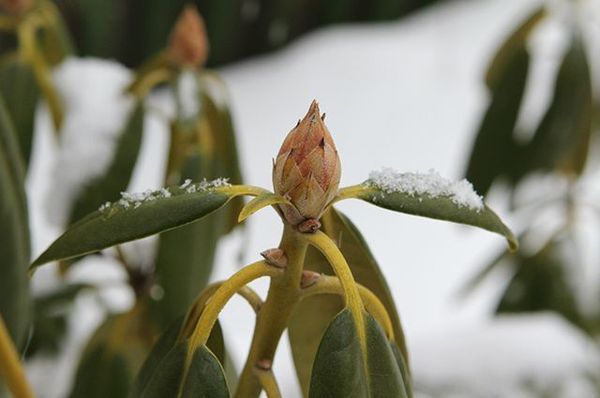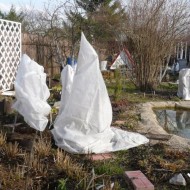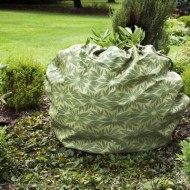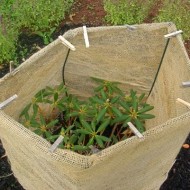Caring for rhododendron in the fall and preparing for winter without much hassle
Content
General rules
Rhododendron, like many ornamental plants, lays flower buds for the next year in the fall. The growing season begins shortly after flowering. All autumn the buds ripen to bloom in the spring and amaze with their splendor. The main task during this period is to make every effort so that the buds do not freeze in winter, and the plants remain in the same form in which they entered the winter.
They begin to cover shrubs no earlier than the daytime temperature drops below 3-5 ° C, and even then, only evergreens, which are more sensitive to cold. Deciduous and semi-evergreen species can be sheltered later when the temperature drops to -10 ° C. Rhododendrons are quite winter hardy, so there is no need to fear that they will freeze. Too early warming, on the contrary, is harmful to the bushes due to the fact that the root collar will begin to undermine.
Video "Preparing for the winter of rhododendrons"
In this video, you will learn how to properly prepare rhododendrons for the winter period.
Pruning and feeding in the fall
Preparing shrubs for winter includes several activities, including pruning and fertilizing, which lay the foundation for a successful wintering. It is worth clarifying right away that these plants do not need formative pruning, since they have a genetically correct bush shape in 99%. Therefore, before wintering, only the removal of damaged shoots is carried out.
The only reason for pruning is to rejuvenate the bush. If it has lost its decorative effect and has ceased to bloom magnificently, then after flowering, the shoots are trimmed 2-3 cm above the level of dormant buds. After 2-3 weeks, the buds will grow, and by next year the decorative effect of the bush will be restored.
It is much more important to provide plants with food for the winter. To do this, a month before the onset of frost, somewhere in the middle of October, phosphorus-potassium mixtures that do not contain nitrogen are introduced. It can be double superphosphate or separately potassium and phosphorus. In order not to burn the thin roots, the shrubs are pre-watered and fertilizers are applied to the wet soil.
The roots of rhododendrons are shallow and shallow, so they cannot stand drought and need watering throughout the fall. The more moisture they absorb, the easier they winter. This is especially important for evergreen varieties. For successful wintering, their leaves must be well saturated with moisture.
Winter shelter
Winter protection for bushes consists of two mandatory measures - mulching the roots and erecting a shelter. To prevent the roots from freezing, they must be covered with a 15–20 cm organic layer (foliage, needles or peat). Sphagnum moss is ideal for this purpose.
The crown of shrubs needs protection not only from frost, but also from the wind, heavy snow, and the scorching February sun. Only a frame shelter can cope with this task. Such structures can be purchased ready-made or built on their own.Let's take a closer look at how and what is the best way to cover rhododendrons for the winter.
Purchased designs
In any garden store, you can buy budget shelters specifically for rhododendrons or azaleas. There is no fundamental difference, since both plants belong to the same species. The shelter is a wire frame, over which a garden batting cover is stretched, which is fixed at the bottom. In use, it is convenient, quickly installed and dismantled, however, many gardeners note the low strength of such structures.
Self-creation
It is safer to make a shelter on your own in the form of a hut or "house" 1–1.4 m high. This design will not allow snow to linger, ensure normal air exchange and prevent damage to branches.
For the construction of the frame, you can use any available materials available on the farm:
- plastic or metal arcs;
- thin boards, wooden beams;
- pieces of metal reinforcement;
- for shelter: garden batting, burlap, corrugated cardboard, plywood;
- small plants can be covered with a cardboard box.
You can not use polyethylene or spunbond for shelter - condensation accumulates under these materials, which leads to debate and rotting of plants.
Landmark for varieties
Varietal characteristics are an important criterion on which the care of rhododendrons and shelter in the fall depends. All shrubs are different: some are sensitive to cold, others to sun and moisture, so each species has its own rules:
- deciduous varieties with flexible shoots up to 1.5 m high for the winter are bent to the ground and sprinkled with a thick layer of foliage, needles or peat;
- low deciduous rhododendrons are tied at the top, and if the bush is very sprawling, it is additionally pulled together with a rope so that the buds do not come into contact with the covering material;
- evergreen species up to 1 m high are covered with a burlap cover, undersized bushes can be covered with spruce branches;
- dwarf Japanese varieties 0.3–0.5 m high are watered abundantly and covered with a cover, sometimes such plants are transplanted into pots and kept in a cool place until spring;
- multi-flowered varieties are not afraid of frost, therefore they are closed only from the sun using a frame covered with non-woven material.
Closing instruction
When making and installing the frame with your own hands, all materials and inventory should be prepared in advance. In the course of work, you will certainly need a saw or jigsaw, a hacksaw for cutting metal, a drill or screwdriver, screws, scissors, twine or flexible plastic fasteners.
Implementation techniques
When deciding on the method of shelter, you need to take into account the age of the shrub, its volume, as well as belonging to the species. Consider a few easy-to-implement options:
- A tent in the form of a wigwam 15–20 cm higher than the plant itself is constructed from 3 bars or pieces of reinforcement. The cover is pulled over the frame so that the bottom lies on the ground. The edges of the cover are fixed with bricks or stones and covered with earth.
- An arc frame with several wire crossbars is constructed from plastic arcs or thick wire. Insulation is thrown over it, tied at the top, and the bottom is pressed with bricks.
- An inclined fence is installed from a metal mesh, on top of which insulation is laid and fixed.
- A quadrangular frame with an inclined roof is made from beams or reinforcement. The top is covered with plywood, and the sides with any insulation. This is a convenient option for low-growing bushes.
Training by area
As mentioned above, rhododendrons are quite winter-hardy, and many varieties in the temperate continental climate of the Moscow region or the Volga region can winter without shelter. Closer to spring, it is enough to simply shade them so that the wind and sun do not damage the shoots. Shelter is necessary only in those regions of the middle zone, where thaws often occur in winter.
For northern regions with long and frosty winters, it is better to choose winter-hardy varieties, but they also need solid shelter. Evergreen shrubs, in addition to the frame and insulation of the roots, are recommended to be completely covered with foliage, straw, or to fill the space in the shelter with these materials.
Major mistakes
What mistakes in the shelter process can interfere with a successful wintering:
- too thin arcs of the frame - they can bend under the weight of snow;
- the close location of the branches to the frame - in contact with the frozen shelter, the buds quickly freeze;
- cover not fixed at the bottom;
- lack of mulch - leads to freezing of the roots;
- insufficient watering in front of the shelter;
- premature shelter;
- use of film.
Winter care for shrubs consists in maintaining the shelter intact: shaking the snow, timely replacement of the covering material in case of damage.
Dismantle the frame in the spring, when not only the air, but also the soil warms up. If the winter is late and the ground has not thawed, you can water the bush with warm water - this procedure will warm the soil and make the plant wake up.






